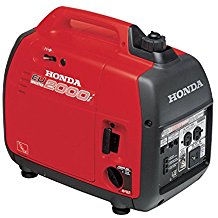User Tools
This is an old revision of the document!
Table of Contents
Generators
 A generator is a device that creates electricity from some other form of energy. In RV terms this usually means a gasoline powered generator, but they can also run on propane or diesel.
A generator is a device that creates electricity from some other form of energy. In RV terms this usually means a gasoline powered generator, but they can also run on propane or diesel.
Note: in some areas solar setups and wind turbines are also called “generators”.
The most common built-in generator found in RVs is the Onan, now owned by Cummins.
The most common high end portable generators are the Honda EU2000-series, inverter generator with Yamaha a close second.
Middling brands include Generac and others.
The lower end is dominated by Champion and other open-frame, non-inverter “contractor” gennies, which are loud but cost 1/3rd as much as Japanese models. Recently some inexpensive inverter generators have come to market, including the Harbor Freight Predator line. Lower-end generators may not be intended for repair, and repair parts may not be available.
Some have reported success with Honda and Yamaha clones like Wen (tested) or Kipor.
etiquette
It is common to leave generators quiet in times of darkness, and to not run them when close to other campers.
charging batteries
Generators are not particularly well-suited to charging lead-acid batteries (flooded, sealed, AGM, etc) on their own. They work best in combination with solar; the generator handles Bulk charging and solar handles the long-duration, low-current Absorption and Float stages.
[Alternator charging + solar can do the same thing for about $950 less – Secessus]
If the generator is being used for some other purpose then by all means add on battery charging. But running a generator for hours at 5% capacity only for charging is not optimal.
Generators are well suited to charging lithium-chemistry batteries as that type can take current at all points of charging.
efficient use
Generators generally have a minimum amount of wattage they can produce. This means that until you hit that minimum multiple loads can be run for “free”, speaking in terms of fuel consumption.
An example of an efficient use would be:
- start the generator in the morning when batteries are most depleted and can take the most current
- use your heavy loads at the same time as possible, up to the practical limit of the generator
- shut the genny down after the battery bank reaches Vabs and let solar handle Absorption and Float stages
maintenance

further reading
- Chinese genny megathread: 3000w Chinese Gensets Info

